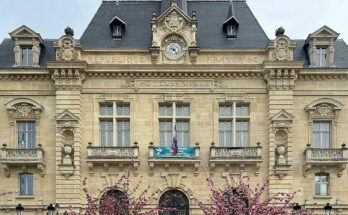Argentine writer and journalist Laura Ramos was eight years old in 1964, when the spy África de las Heras was waiting for her outside the Francia school in Montevideo, Uruguay. At that point neither she nor her brother Víctor knew the true identity of this Spanish woman who was one of the most valuable Soviet agents of the 20th century. They also did not know that his code name in the KGB was Patria (Homeland). Nor that years earlier, in Mexico, she had infiltrated Leon Trotsky’s inner circle as María de la Sierra. For them she was simply María Luisa, the lady who took them to her house, two blocks from the school, and looked after them until their mother came to pick them up, and every now and then she sewed things for them.
When her brother asked her in 2018 if she remembered María Luisa, Ramos replied: “The seamstress!” In his mind he saw “a very sober, completely unremarkable person with graying hair, wearing long skirts and carrying a packet of pastries from the Rhine Gold confectionery”. A woman, he continued, who was “very pleasant to be around, who treated you as an equal, but not affectionate or affectionate towards us.”
After learning that she was neither a seamstress nor a nanny, and that this identity was simply a mask behind which she had hidden for two decades to run the KGB’s spy network in South America, the image was shattered. The memories began to mix with what Ramos discovered in five years of investigation, which led to the book My KGB nanny (My KGB nanny): “I would later discover that our nanny poisoned her husband, an Italian spy,” and “a chilling recording revealed a second crime: her involvement in the assassination of (Leon) Trotsky.”
Laura Ramos, 69 years old, welcomes EL PAÍS into her home in Buenos Aires. Her dog Ramoncita, still a puppy, runs around while the conversation delves into the secrets of a woman who participated in espionage operations on both sides of the Atlantic. África de las Heras was born in the Spanish exclave of Ceuta in 1909 and died in Moscow in 1988, having lived six different lives in the meantime. She was a textile worker in Madrid, a militiaman in republican Barcelona, a secretary in Mexico, a radio operator in Ukraine, a seamstress in Paris and a nanny in Uruguay.
De las Heras deceived everyone who knew her. Among these were Ramos’ mother, the Argentine feminist Faby Carvallo – known as “La Maga” – and the circle of Uruguayan intellectuals with whom she surrounded herself in Montevideo.
“The Uruguayans who knew her were proud because she was an international heroine who saved the lives of dozens of Spaniards fleeing the war for France by helping them cross the border, and who also parachuted into Ukraine, in the territories occupied by the Nazis, to report from there. But they also felt stupid. Because in Montevideo she was treated with condescension, not as an equal, and she had to overcome those prejudices. Prejudices not only for being Spanish, but also for being older, for don’t have children…”
Married to Felisberto Hernández
They also struggled to accept that all of them were nothing more than a front. An experience that extended to many other people and which, in preparation for the stay in Uruguay, began with the seduction of the musician and writer Felisberto Hernández in Paris. She wanted to be a seamstress and as such she arrived in Montevideo. They married in 1948 and were unhappy for two years.
Hernández, a fervent anti-Communist, never discovered that his wife was transmitting coded messages to Moscow or that she was the head of his spy network in South America, although she could well have been one of the characters created by his exuberant imagination. “As night fell I could hear María’s footsteps, the gong that started the water and the noise of the engines. But I was already bored and I didn’t want to be surprised by anything”, wrote the novelist in his story “The Flooded House”.
Following the atomic trail
De las Heras settled in Uruguay “because at that time Stalin wanted information on the atomic bomb,” explains the interviewee. “To go to the United States, he needed a foothold somewhere, and Montevideo was perfect because (Uruguay) was known as the Switzerland of America, a peaceful country, with political stability and a very friendly atmosphere. In addition, it had a Russian representation, which allowed them to have legal spies and facilitated the creation of the whole illegal system. They decided that it was the best option to create a center of radio operators who could communicate with Moscow. She was in charge of Latin America. Her mission was to prepare documents and all the cover for the Soviet spies who “were going to the United States.”
Once she got what she needed from Hernández – regularizing his legal status and building a network of friends – she abandoned him. She remarried, this time marrying Italian citizen Valentino Marchetti, another Soviet spy whose real name was Giovanni Antonio Bertoni. Ramos suspects that Bertoni’s sudden death in 1964 was not natural, but a murder committed by his wife: “It happened at a time of year when she came to pick us up from school. She gave us tea in the same place where she poisoned her husband in the afternoon.”

The bullet intended for Che
This is not the only murder that Laura Ramos attributes to her in the book. She believes that Trotsky’s assassin, Ramón Mercader, and De las Heras were lovers and that she may have infiltrated the exiled leader’s inner circle to copy the plans of the house where he lived in Mexico, thus facilitating the operation that ended his life. Ramos also considers it likely that she planned the assassination of the historian Arbelio Rodríguez, as his widow, Esther Dosil, accused her of doing so.
For Uruguayans, Rodríguez is a hero hit by a bullet not intended for him. That bullet was intended for Che Guevara as he left the University of the Republic in Montevideo. Dosil’s version, accepted as true by Ramos, states that the real target was Ramírez, perhaps because he had refused to collaborate with the KGB. “The same doctor who performed Arbelio Ramírez’s autopsy is the one who issued Valentino’s death certificate,” Ramos says of the latest evidence obtained that strengthens his suspicions.
The children of Ramírez and Dosil spoke to the writer, each separately: “They are like Cain and Abel, they hate each other, they haven’t spoken to each other for years. And all because of what? Because of María Luisa. María Luisa is at the center of this family’s drama.”
An in-depth investigation
As in his previous books, the author conducted rigorous research. He went to Ceuta, the birthplace of África de las Heras in 1909, where the conservative family with which he severed ties still resides; in mainland Spain, where she worked as a textile worker and member of the republican militia before disappearing without a trace in 1937 to begin living with a new identity; to the Mitrokhin Archive in Cambridge, where he found his nanny’s name among KGB intelligence operations; and also in Montevideo, where the search for information was intertwined with the memories of a childhood that he did not want to see again: “I resisted a lot. I didn’t want to return to the world of my parents, to their ideologies, to their lovers, to their revolution”.
The daughter of the influential politician and writer Jorge Abelardo Ramos and Carvallo, both Trotskyists, Ramos grew up among intellectuals and tried to escape the ideal they dreamed for her: “a modern girl in the style of those lesbian dolls, with a bob haircut and a plaid tracksuit.” In contrast to the “living dangerously” that was her mother’s leitmotif – “cap, black cigarette, high-waisted trousers, open shirt knotted under the bust, you could almost hear the jazz music” – she secretly read the moralizing saga of Little Women.
From those youthful readings arose a love for the nineteenth century which grew with the writing of some of his books, such as The ladies (The Misses) e Infernal. The Brontë Brotherhood (Infernal: The Brontë Sisterhood). Even the living room of her home, decorated with a Norah Borges drawing and a window that opens onto a peaceful community garden, seems suspended in time.

Ramos denies that her new book has reconciled her with her childhood: “Instead of reconciling myself with myself, I made a forced, entirely artificial change, romanticizing that past. I turned our childhood in the 1960s into something magical. It was truly a utopian community where we lived. Someone would lend you this or that, take care of your children, cook for you; you spent one Christmas in one house, another in another house, and we all cleaned the place together. I added to these a bit of the spirit of Jane Austen. protoguerrillas, these left-wing Uruguayans of the sixties”.
Digging into her past through the testimonies of others, the author also discovered a different image of her late mother, to whom she dedicates the book. “Suddenly it took on a more historical dimension, because she was a feminist activist in Buenos Aires in the 1970s, but even before that, from a very young age, she had adopted those ways and those ideas. And there was something about her that wasn’t just feminism, but rather her way of life, so unique, so unconventional from the outside, but which made her a sort of embodiment of poetry when she took us to the beach to watch the storms. I was suffering because I was cold and I hate the sea – yes, I still hate the sea and I am very sensitive to the cold – but despite that, I believe that that poetry and that light with which it bathed me is who I am, just Someone who could write all this and enjoy it.
Sign up to our weekly newsletter to get more English-language news coverage from EL PAÍS USA Edition



